remove seats Citroen GRAND C4 PICASSO RHD 2016 2.G Owner's Manual
[x] Cancel search | Manufacturer: CITROEN, Model Year: 2016, Model line: GRAND C4 PICASSO RHD, Model: Citroen GRAND C4 PICASSO RHD 2016 2.GPages: 523, PDF Size: 13.63 MB
Page 12 of 523
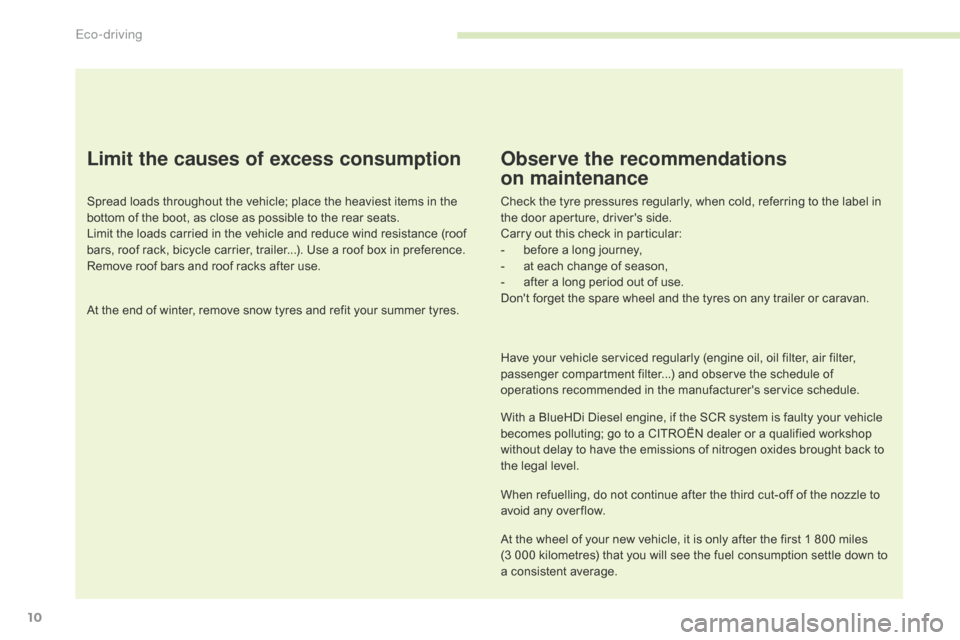
10
Limit the causes of excess consumption
Spread loads throughout the vehicle; place the heaviest items in the bottom of the boot, as close as possible to the rear seats.
Limit
the loads carried in the vehicle and reduce wind resistance (roof
b
ars, roof rack, bicycle carrier, trailer...). Use a roof box in preference.
Remove
roof bars and roof racks after use.
At
the end of winter, remove snow tyres and refit your summer tyres.
Observe the recommendations
on maintenance
Check the tyre pressures regularly, when cold, referring to the label in the door aperture, driver's side.
Carry
out this check in particular:
-
b
efore a long journey,
-
a
t each change of season,
-
a
fter a long period out of use.
Don't
forget the spare wheel and the tyres on any trailer or caravan.
Have
your vehicle serviced regularly (engine oil, oil filter, air filter,
p
assenger compartment filter...) and observe the schedule of
o
perations recommended in the manufacturer's service schedule.
With
a BlueHDi Diesel engine, if the SCR system is faulty your vehicle
b
ecomes polluting; go to a CITROËN dealer or a qualified workshop
w
ithout delay to have the emissions of nitrogen oxides brought back to
t
he legal level.
When
refuelling, do not continue after the third cut-off of the nozzle to
a
void any over flow.
At
the wheel of your new vehicle, it is only after the first 1 800 miles
(
3 000 kilometres) that you will see the fuel consumption settle down to
a
consistent average.
Eco-driving
Page 85 of 523
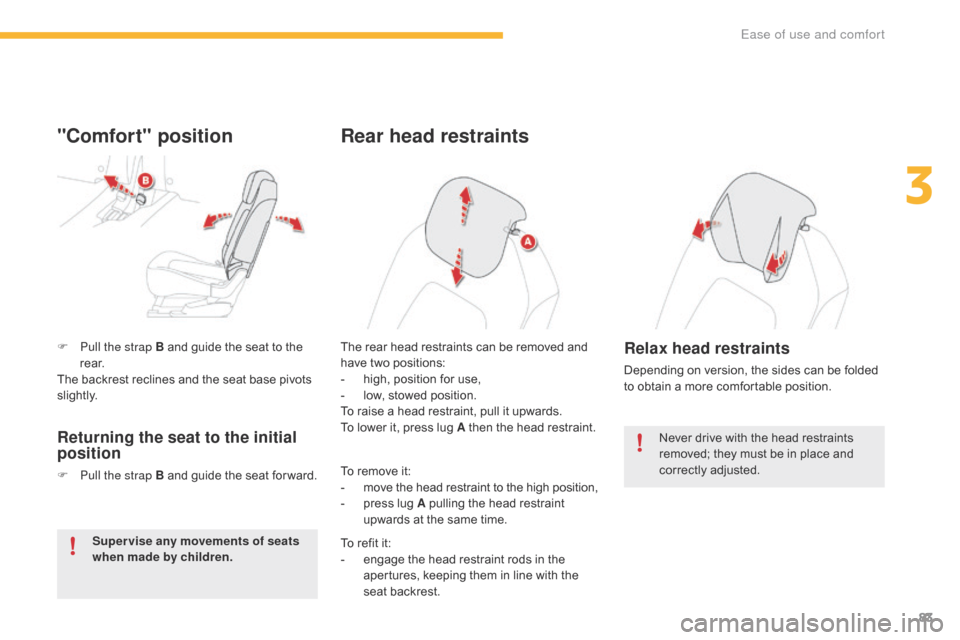
83
F Pull the strap B and guide the seat to the r
e a r.
The
backrest reclines and the seat base pivots
s
li g ht l y.
"Comfort" position
Returning the seat to the initial
position
F Pull the strap B and guide the seat for ward.
Super vise any movements of seats
when made by children. To
remove it:
- m ove the head restraint to the high position,
-
p
ress lug A pulling the head restraint
u
pwards at the same time.
The
rear head restraints can be removed and
h
ave two positions:
-
h
igh, position for use,
-
l
ow, stowed position.
To raise a head restraint, pull it upwards.
To lower it, press lug A then the head restraint.
Rear head restraints
Never drive with the head restraints r
emoved; they must be in place and
c
orrectly
adj
usted.
To
refit
it:
-
e
ngage
the
head
restraint
rods
in
the
a
pertures,
keeping
them
in
line
with
the
s
eat
backrest.
Relax head restraints
Depending on version, the sides can be folded t o obtain a more comfortable position.
3
Ease of use and comfort
Page 89 of 523
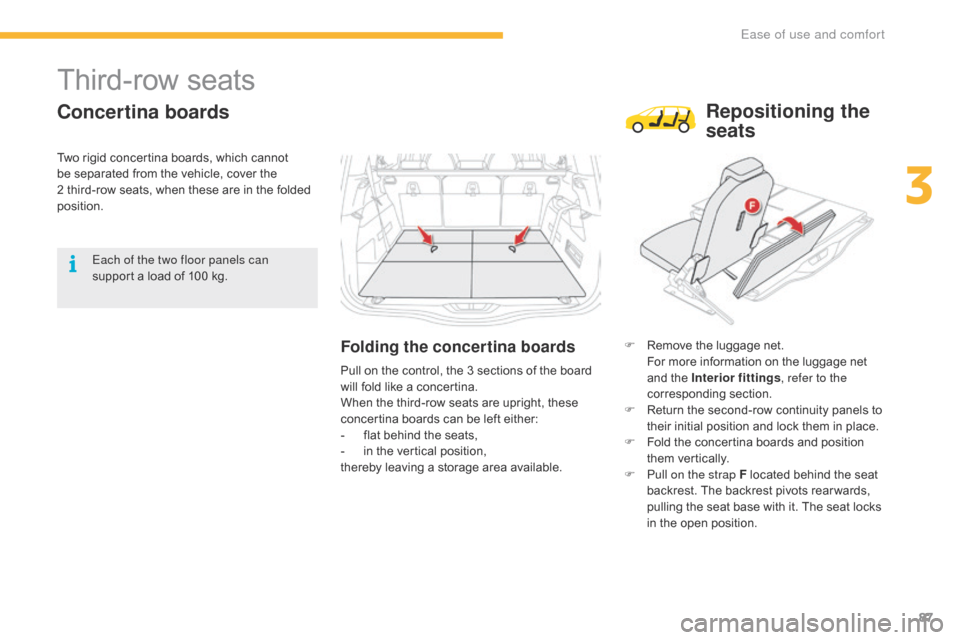
87
Third-row seats
Concertina boards
Folding the concertina boardsF Remove the luggage net. F
or more information on the luggage net
a
nd the Interior fittings , refer to the
corresponding
s
ection.
F
R
eturn the second-row continuity panels to
t
heir initial position and lock them in place.
F
F
old the concertina boards and position
t
hem
v
ertically.
F
P
ull on the strap F located behind the seat
b
ackrest. The backrest pivots rear wards,
p
ulling the seat base with it. The seat locks
i
n the open position.
Each of the two floor panels can
support
a
load
of
100
kg.
Pull
on
the
control,
the
3
sections
of
the
board
w
ill
fold
like
a
concertina.
When
the
third-row
seats
are
upright,
these
c
oncertina
boards
can
be
left
either:
-
f
lat
behind
the
seats,
-
i
n
the
vertical
position,
thereby
leaving
a
storage
area
available.
Repositioning the
seats
Two rigid concertina boards, which cannot b e separated from the vehicle, cover the
2 t
hird-row seats, when these are in the folded
p
osition.
3
Ease of use and comfort
Page 116 of 523
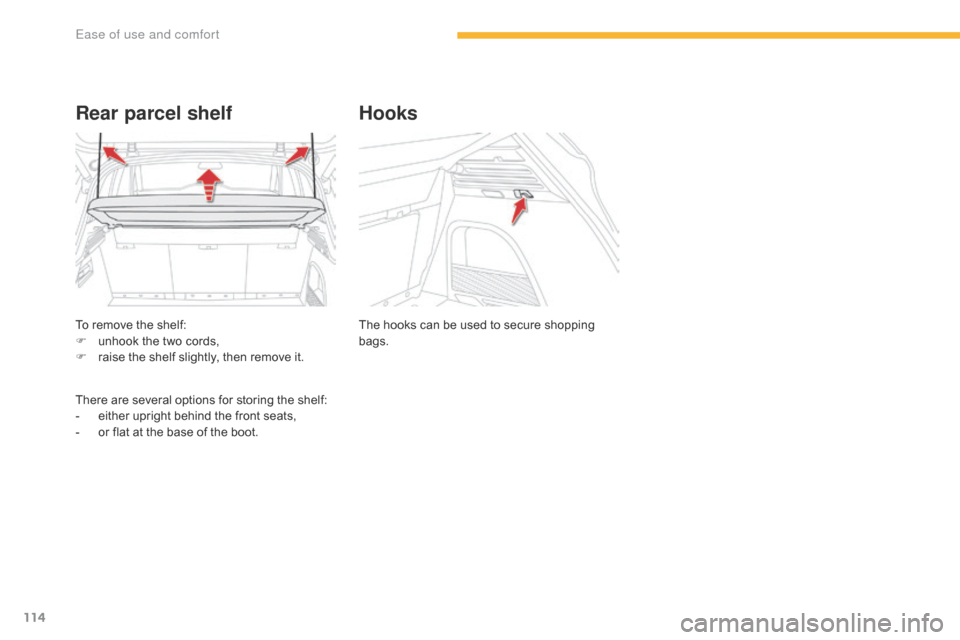
114
To remove the shelf:
F u nhook the two cords,
F
r
aise the shelf slightly, then remove it.
Rear parcel shelf
There are several options for storing the shelf:
- e ither upright behind the front seats,
-
o
r flat at the base of the boot.The
hooks can be used to secure shopping
b
ags.
Hooks
Ease of use and comfort
Page 237 of 523
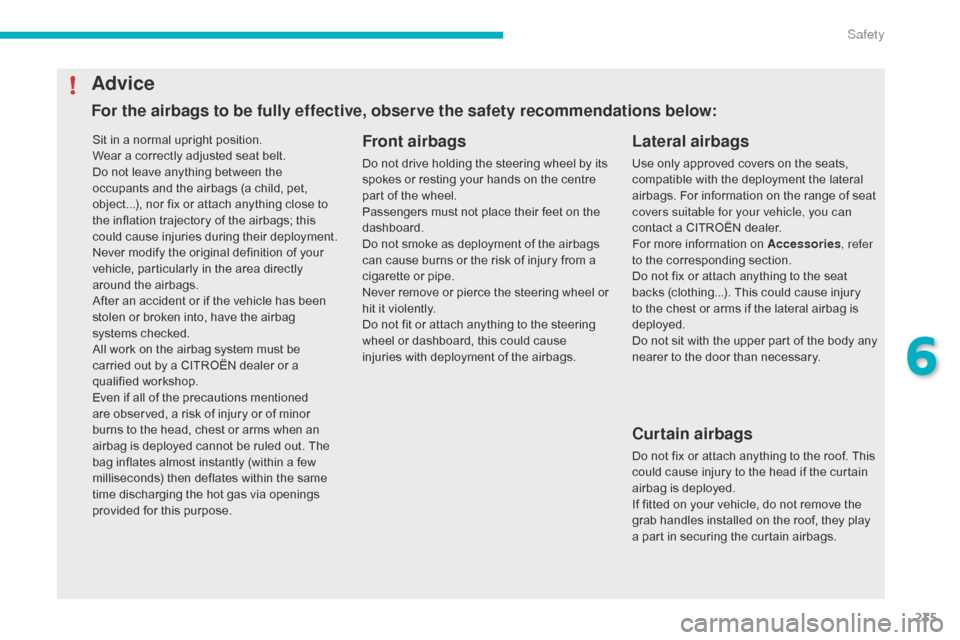
235
Sit in a normal upright position.
W ear a correctly adjusted seat belt.
Do
not leave anything between the
o
ccupants and the airbags (a child, pet,
o
bject...), nor fix or attach anything close to
t
he inflation trajectory of the airbags; this
c
ould cause injuries during their deployment.
Never
modify the original definition of your
v
ehicle, particularly in the area directly
a
round the airbags.
After
an accident or if the vehicle has been
s
tolen or broken into, have the airbag
s
ystems checked.
All
work on the airbag system must be
c
arried out by a CITROËN dealer or a
q
ualified
w
orkshop.
Even
if all of the precautions mentioned
a
re observed, a risk of injury or of minor
b
urns to the head, chest or arms when an
a
irbag is deployed cannot be ruled out. The
b
ag inflates almost instantly (within a few
m
illiseconds) then deflates within the same
t
ime discharging the hot gas via openings
p
rovided for this purpose.Front airbags
Do not drive holding the steering wheel by its spokes or resting your hands on the centre
p
art of the wheel.
Passengers
must not place their feet on the
das
hboard.
Do
not smoke as deployment of the airbags
c
an cause burns or the risk of injury from a
c
igarette or pipe.
Never
remove
or
pierce
the
steering
wheel
or
h
it it violently.
Do
not fit or attach anything to the steering
w
heel or dashboard, this could cause
i
njuries with deployment of the airbags.
Advice
Lateral airbags
Use only approved covers on the seats, compatible with the deployment the lateral
a
irbags. For information on the range of seat
c
overs suitable for your vehicle, you can
contact
a CITROËN dealer.
For
more information on Accessories, refer
to
the corresponding section.
Do
not fix or attach anything to the seat
b
acks (clothing...). This could cause injury
t
o the chest or arms if the lateral airbag is
d
eployed.
Do
not sit with the upper part of the body any
n
earer to the door than necessary.
Curtain airbags
Do not fix or attach anything to the roof. This could cause injury to the head if the curtain
a
irbag is deployed.
If
fitted on your vehicle, do not remove the
g
rab handles installed on the roof, they play
a
part in securing the curtain airbags.
For the airbags to be fully effective, observe the safety recommendations below:
6
Safety
Page 246 of 523
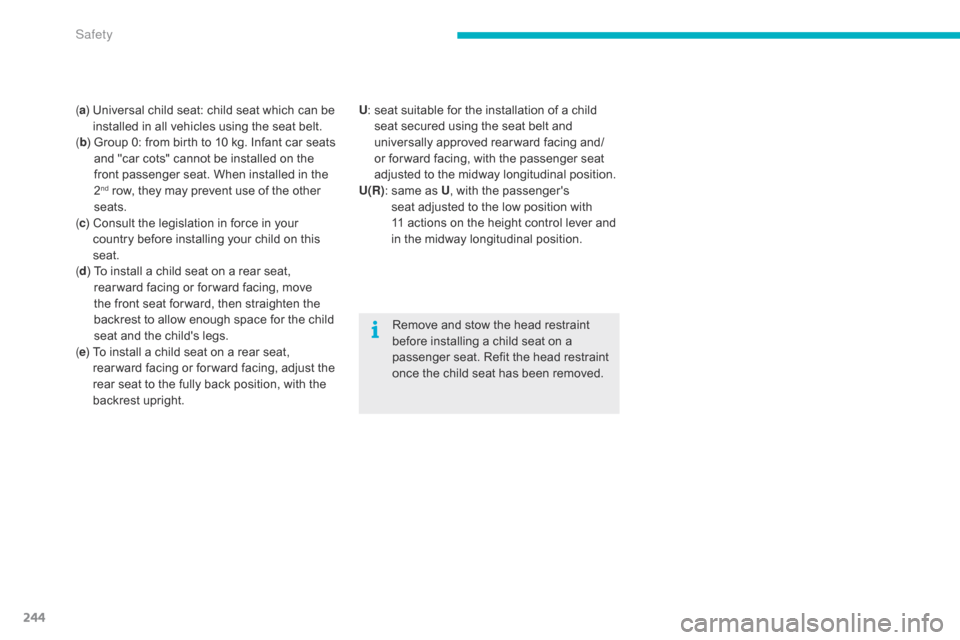
244
(a ) Universal child seat: child seat which can be i
nstalled in all vehicles using the seat belt.
( b )
G
roup 0: from birth to 10 kg. Infant car seats
a
nd "car cots" cannot be installed on the
f
ront passenger seat. When installed in the
2nd row, they may prevent use of the other seats.
( c )
C
onsult the legislation in force in your
c
ountry before installing your child on this
sea
t.
( d )
T
o
install a child seat on a rear seat,
r
ear ward facing or for ward facing, move
t
he front seat for ward, then straighten the
b
ackrest to allow enough space for the child
s
eat and the child's legs.
( e )
T
o
install a child seat on a rear seat,
r
ear ward facing or for ward facing, adjust the
r
ear seat to the fully back position, with the
b
ackrest upright. Remove
and stow the head restraint
b
efore installing a child seat on a
p
assenger seat. Refit the head restraint
o
nce the child seat has been removed.
U
:
s
eat suitable for the installation of a child
s
eat secured using the seat belt and
u
niversally approved rear ward facing and/
or for ward facing, with the passenger seat
a
djusted to the midway longitudinal position.
U(R) : s ame as U
, with the passenger's s
eat adjusted to the low position with
1
1 actions on the height control lever and
i
n the midway longitudinal position.
Safety
Page 248 of 523
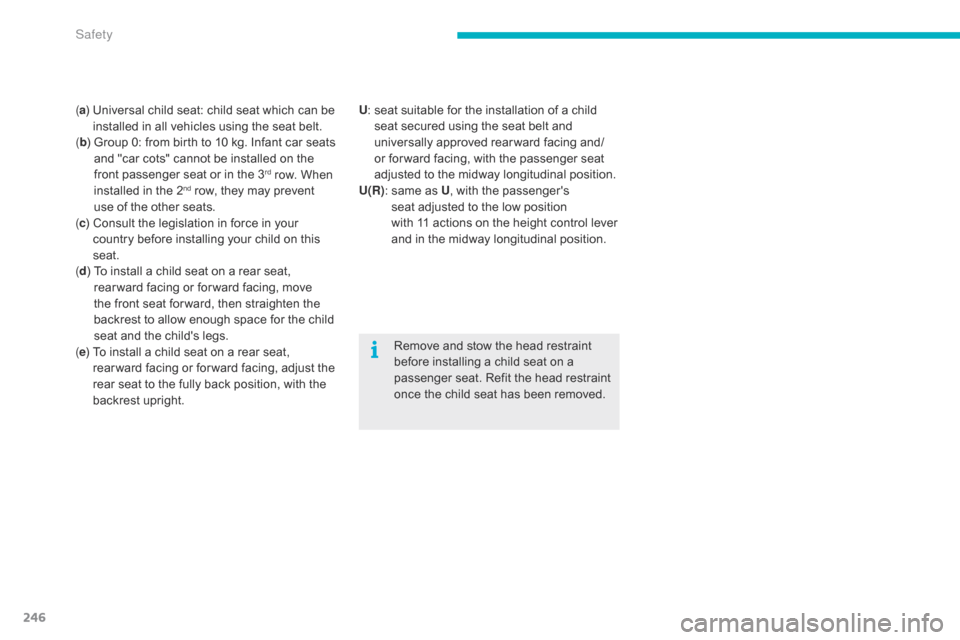
246
(a ) Universal child seat: child seat which can be i
nstalled in all vehicles using the seat belt.
( b )
G
roup 0: from birth to 10 kg. Infant car seats
a
nd "car cots" cannot be installed on the
f
ront passenger seat or in the 3
rd row. When i
nstalled
in
the
2nd row, they may prevent u
se
of
the
other
seats.
( c )
C
onsult
the
legislation in force in your
c
ountry
before
installing your child on this
sea
t.
( d )
T
o
install
a
child
seat on a rear seat,
r
ear ward
facing
or for ward facing, move
t
he
front
seat
for ward, then straighten the
b
ackrest
to
allow
enough space for the child
s
eat
and
the
child's legs.
( e )
T
o
install
a
child
seat on a rear seat,
r
ear ward
facing
or for ward facing, adjust the
r
ear
seat
to
the
fully back position, with the
b
ackrest
upright. Remove
and stow the head restraint
b
efore installing a child seat on a
p
assenger seat. Refit the head restraint
o
nce the child seat has been removed.
U
:
s
eat suitable for the installation of a child
s
eat secured using the seat belt and
u
niversally approved rear ward facing and/
or for ward facing, with the passenger seat
a
djusted to the midway longitudinal position.
U(R) : s ame as U
, with the passenger's s
eat adjusted to the low position
w
ith 11 actions on the height control lever
a
nd in the midway longitudinal position.
Safety
Page 249 of 523
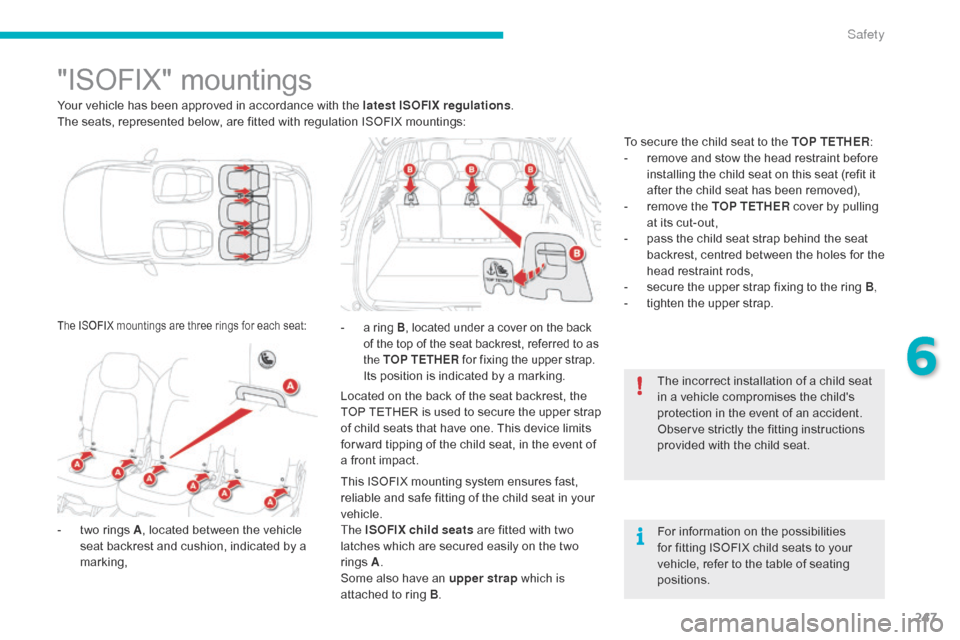
247
"ISOFIX" mountings
Your vehicle has been approved in accordance with the latest ISOFIX regulations .
T he seats, represented below, are fitted with regulation ISOFIX mountings:
-
t
wo rings A,
located between the vehicle
s
eat backrest and cushion, indicated by a
m
arking, -
a ring B, located under a cover on the back o
f the top of the seat backrest, referred to as
t
he TOP TETHER for fixing the upper strap.
Its position is indicated by a marking.
Located on the back of the seat backrest, the
T
OP
T
ETHER
i
s
u
sed
t
o
s
ecure
t
he
u
pper
s
trap
o
f child seats that have one. This device limits
f
or ward tipping of the child seat, in the event of
a
front impact. The
incorrect installation of a child seat
i
n a vehicle compromises the child's
p
rotection in the event of an accident.
Observe
strictly the fitting instructions
p
rovided with the child seat.
For
information on the possibilities
f
or fitting ISOFIX child seats to your
v
ehicle, refer to the table of seating
p
ositions.
The ISOFIX mountings are three rings for each seat:
This ISOFIX mounting system ensures fast, reliable and safe fitting of the child seat in your
v
ehicle.
The ISOFIX child seats
are fitted with two
l
atches which are secured easily on the two
r
ings
A .
S
ome also have an upper strap which is
attached
to ring B. To
secure the child seat to the TOP TETHER
:
-
r
emove and stow the head restraint before
i
nstalling the child seat on this seat (refit it
a
fter the child seat has been removed),
-
r
emove the TOP TETHER cover by pulling
a
t its cut-out,
-
p
ass the child seat strap behind the seat
b
ackrest, centred between the holes for the
h
ead restraint rods,
-
s
ecure the upper strap fixing to the ring B,
-
t
ighten the upper strap.
6
Safety
Page 252 of 523
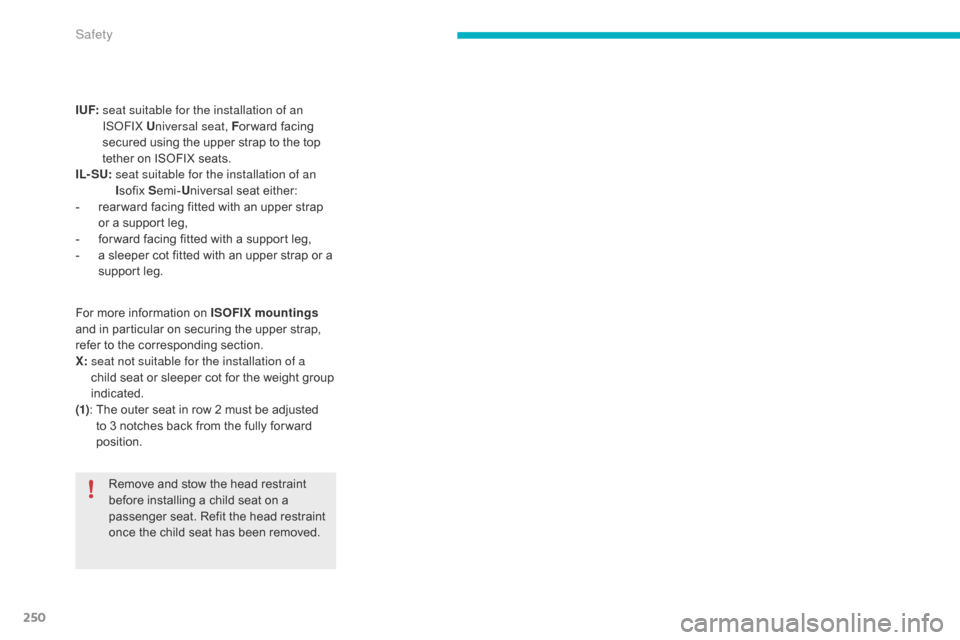
250
I UF: seat suitable for the installation of an
ISOFIX U niversal seat, F or ward
facing
s
ecured using the upper strap to the top
t
ether on ISOFIX seats.
IL- SU:
s
eat suitable for the installation of an
I sofix
Semi- Universal
sea
t
ei
ther:
-
r
ear ward facing fitted with an upper strap
o
r a support leg,
-
f
or ward facing fitted with a support leg,
-
a
sleeper cot fitted with an upper strap or a
s
upport leg.
Remove
and stow the head restraint
b
efore installing a child seat on a
p
assenger seat. Refit the head restraint
o
nce the child seat has been removed.
For
more information on ISOFIX mountings
and
in particular on securing the upper strap,
r
efer to the corresponding section.
X:
s
eat not suitable for the installation of a
child
seat or sleeper cot for the weight group
i
ndicated.
(1) :
T
he outer seat in row 2 must be adjusted
t
o 3 notches back from the fully for ward
p
osition.
Safety
Page 254 of 523
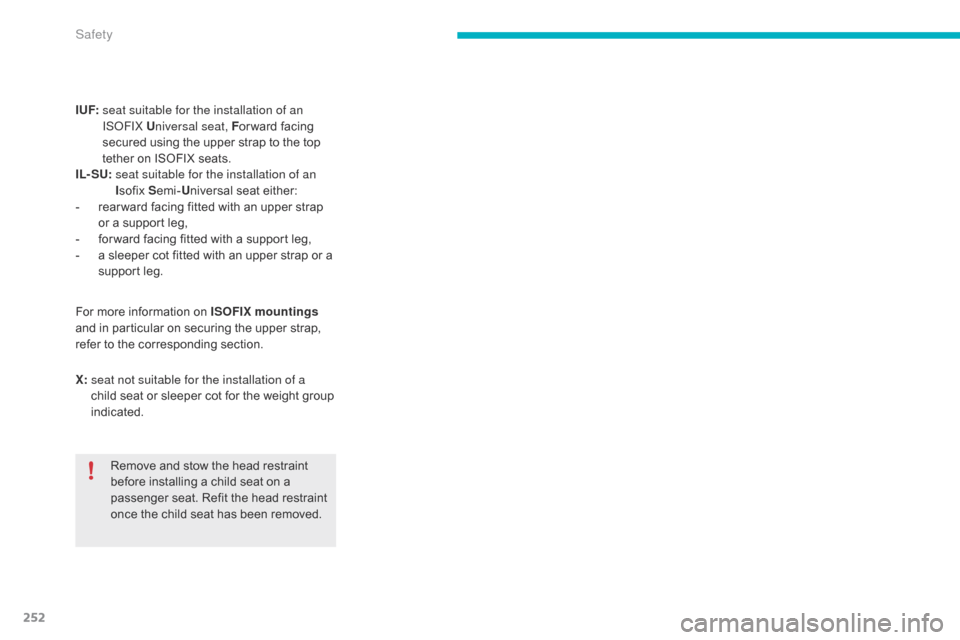
252
I UF: seat suitable for the installation of an
ISOFIX U niversal seat, F or ward
facing
s
ecured using the upper strap to the top
t
ether on ISOFIX seats.
IL- SU:
s
eat suitable for the installation of an
I sofix
Semi- Universal
sea
t
ei
ther:
-
r
ear ward facing fitted with an upper strap
o
r a support leg,
-
f
or ward facing fitted with a support leg,
-
a
sleeper cot fitted with an upper strap or a
s
upport leg.
Remove
and stow the head restraint
b
efore installing a child seat on a
p
assenger seat. Refit the head restraint
o
nce the child seat has been removed.
For
more information on ISOFIX mountings
and
in particular on securing the upper strap,
r
efer to the corresponding section.
X:
s
eat not suitable for the installation of a
child
seat or sleeper cot for the weight group
i
ndicated.
Safety